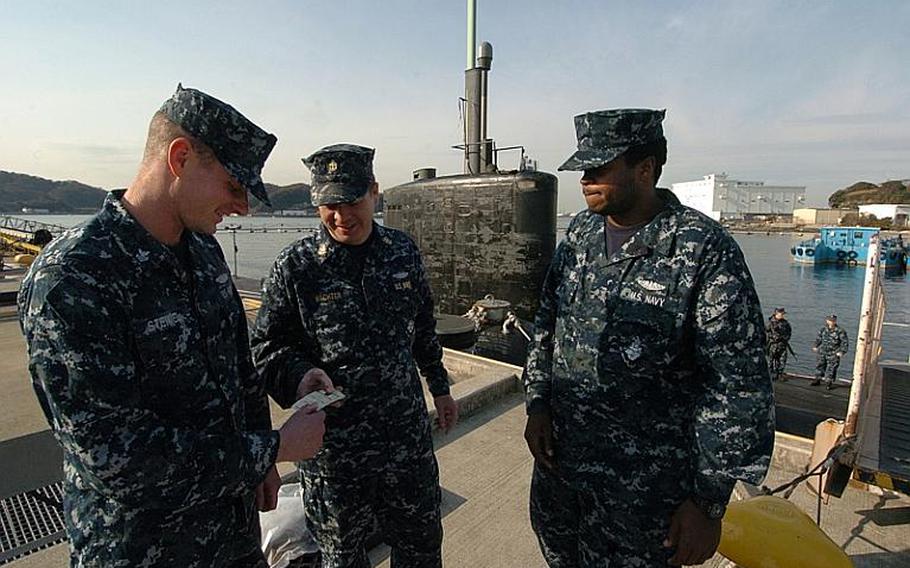
Chief Petty Officer Mark Wachter, center, hands out nicotine gum to Petty Officer 1st Class John Steimel, left, and Seaman Shaquan Topping during a USS Charlotte port visit Thursday at Yokosuka Naval Base, Japan. (Erik Slavin/Stars and Stripes)
YOKOSUKA NAVAL BASE, Japan — As Petty Officer 2nd Class William Bancroft described those first few days of the Navy’s smoking ban aboard submarines, his steely glare resembled Clint Eastwood’s in “The Good, the Bad and the Ugly,” right before he shoots somebody.
“It was intense,” said Bancroft, while taking a break on a pier where the fast-attack submarine USS Charlotte was moored during a recent port visit to Yokosuka Naval Base.
How intense?
Bancroft, a cook aboard the USS Charlotte, held up an imaginary spatula.
“You want WHAT IN YOUR OMELET???” he barked, before laughing off those tense days of nicotine withdrawal with a few other crewmembers.
Fortunately, Bancroft mellowed out before ever serving up bacon and eggs with a side of cyanide.
Bancroft is one of the many sailors aboard the Navy’s 71 submarines who are learning to live with the ban, which began fleet-wide Jan. 1 because of secondhand smoke concerns aboard the tightly packed vessels. The ban kicked in for the Charlotte when it departed its homeport of Hawaii on Oct. 16, so it wouldn’t take effect in the middle of the deployment.
Submariners don’t have to give up nicotine entirely. Chewing tobacco and electronic cigarettes are still allowed, and sailors can smoke when they leave the boat during port visits.
However, some longtime smokers aboard the Charlotte are using the ban as motivation to quit for good.
Chief Petty Officer Mark Wachter, 45, of The Bronx, N.Y., is quitting after 29 years of smoking, including 19 years of smoking up to two packs a day on submarines.
Those first few days without a cigarette were filled with “a lot of patches, a lot of gum and some anger management issues,” Wachter said.
Wachter admits he was harder on some sailors than he should have been at the time, but he and other smokers say that their initial prickliness soon went away.
Non-smokers aboard said that none of their co-workers changed for the worse after quitting.
“I haven’t seen any significant personality changes at all,” said boat engineer Lt. Cmdr. Chris Carter.
Carter says he and others, like the sailors who stand watch near what formerly served as one of the ship’s two designated “smoke pits,” appreciate the cleaner air. The elimination of cigarette smoke is also better for some of the submarine’s equipment, he said.
Multiple smokers said one of the toughest parts of quitting has been dealing with the change in routine, which became so ingrained that after the ban, one sailor said he found himself wandering over to the smoke pit without a cigarette, and then asking himself why he came there in the first place.
Others find themselves hitting the galley for a midnight snack more often.
Petty Officer 1st Class John Steimel, 32, of Pocahontas, Ark., said he’s gained about 10 pounds since he began fighting his pack-and-a-half per day habit, eating whatever is available.
Wachter nodded in agreement. “Chocolate, anything chocolate,” he said. “M and Ms, chocolate milk – put it in front of me, and it’s gone.”
Crewmembers said between 30 percent to 50 percent of the Charlotte’s 132 crewmembers smoked before the boat got underway Oct. 16. Some have relapsed while on land, but that is normal; 75 percent of smokers need more than one try to kick the habit, according to the National Institutes of Health.
It’s easy to spot the sailors who haven’t given up smoking when the Charlotte pulls into port. They’re the ones at the front of the line to get off the boat.
Taking that first drag has become an unintended motivator for some sailors to work a little harder before arrival, said Seaman Shaquan Topping, 23, of Belhaven, N.C.
“People can’t go smoke until we take care of several things,” Topping said. “Stuff gets done a lot quicker now.”
if(typeof(dstb)!= "undefined"){ dstb();}
if(typeof(dstb)!= "undefined"){ dstb();}
if(typeof(dstb)!= "undefined"){ dstb();}
if(typeof(dstb)!= "undefined"){ dstb();}
if(typeof(dstb)!= "undefined"){ dstb();}
if(typeof(dstb)!= "undefined"){ dstb();}
if(typeof(dstb)!= "undefined"){ dstb();}